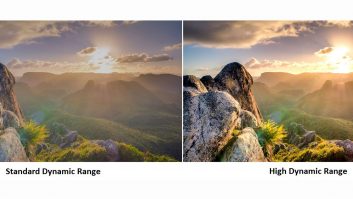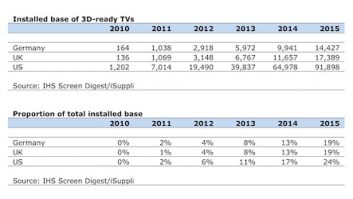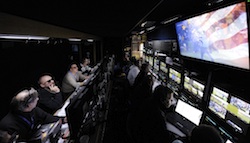
HDTV to 3DTV – Stan Moote, VP corporate development, and Chris Lennon, director of integration and standards, CTO Group, Harris Broadcast Communications, clear up some misconceptions and confusion about the technologies being used for 3DTV, and their impact on broadcast infrastructure.
Looking at the EBU survey stats from last summer, it appears that very few European broadcasters have even migrated their production facilities over to HD, yet here we are already in the midst of the next big push: 3DTV. In reality, considering a possible 3D future is far less intimidating than you may think, and understanding a few key points will help you set a clear direction for your facility.
More than one flavour: One of the key areas of frustration for broadcasters is the confusion surrounding the various 3D technologies that exist. It really is quite simple, as all current 3D technologies fall into one of three groupings: Dual Stream, 2D + Difference and Frame-compatible formats.
An example of Dual Stream is two feeds directly out of two cameras set up for left and right views. The 2D + Difference approach, which has enjoyed success in gaming and other areas, involves taking a traditional 2D picture and adding to it metadata describing the difference between the left and right eye view to allow TVs to render the second eye view.
Blu-ray is going with MPEG’s MVC (Multiview Video Coding) extension of H.264/MPEG-4 AVC, which supplements a traditional 2D view with metadata enabling the construction of the second eye view. Frame-compatible approaches, such as over-under and side-by-side, are favoured by cable and satellite providers.
It’s important to know that the format used in production, post production and processing in your facility need not match the format used in transmission or viewing. Practically, we should think about 3DTV in a similar fashion to SD and HD signals — with just a few exceptions.
Production (post): There is no question that preserving the two streams in the highest quality possible is most important — mezzanine I-Frame compression only. As for monitoring the use of 3DTV content, active shutter glasses should be used with full-bandwidth video into the monitor. During the post production process, metadata tagging of composited layers is of utmost importance.
When it comes to graphics systems in a 3D world, it’s going to be vital that you work with a vendor in this area who has an in-depth (pun intended) understanding of 3DTV. Not only does how the graphics are built and placed on the picture matter, but the quantity of graphics used (less is generally more in the world of 3DTV) is also of equal importance.
In a production truck, those not using 3Gbps infrastructure will have to consider router size very carefully. Early indicators are that 64×64 — and in some cases, even 256×256 routers — become stretched beyond their limits when having to deal with dual 1.5Gbps video paths.
In plant:Ideally, 3DTV video within a broadcast facility will match up with the HD plant format. The left and right eye streams will be 1080i or 720p on a single 3Gbps or two 1.5Gbps coax. Compression for storage is a touchy subject. Longer GOP compression is being used more and more for HD quite successfully. As we know, there are always compression artefacts; however, in 3DTV, we need to ensure that the artefacts are the same on both the left and right channels. Practically speaking, the only way to ensure this is to use higher compression bit rates than typically used for HD.
Typically, several channels are being run together within a facility, and this makes the monitoring of several monitors on the same wall difficult to impossible with active shuttered glasses. Monitor walls and multiviewers are best suited for passive polarised glasses.
Finally, if you require both 2D and 3D versions of your production, don’t always assume that you can simply take the left eye view of the 3DTV version and have a good 2D version. The single eye view of a 3DTV shot doesn’t always translate well into 2D.
Contribution: Whether the 3DTV content is back-hauled from an event or being sent out to affiliates, preserving the left and right eye channel is of prime importance. Naturally, dark fibre is the best option, running at 3Gbps. The next best options are using two streams with a synchronised MPEG higher bit rate encoding process or higher bit 2D plus Difference approach mentioned earlier.
Distribution:Ultimately, we believe we will see 2D + Difference or some other full-resolution approach to 3DTV for distribution in the long term. For now, however, that isn’t going to happen, as current cable and satellite paths and STBs will be used.
The best approach is squeezing the video by half and putting left and right channel adjacent within the same stream. This is most commonly done either side by side, or one above the other. As this preserves the frame (and field) nature of the video, it can go through today’s compression engines and links generating the same artefacts on both channels. Viewing of 3DTV at home will be using active shuttered glasses.
Are you ready now?
The key takeaway here is that a 3Gbps infrastructure will be a great investment for your future ability to handle 3D video. Speak with your primary vendor(s) and enquire as to the readiness of the products you currently use to handle 3DTV.
In some cases, they may be ready; in others, an upgrade may be necessary or two units slaved together. With any luck, replacement of equipment will not be required in many cases. And that’s an answer sure to win you some points the day your boss walks in and asks the dreaded 3DTV question.







